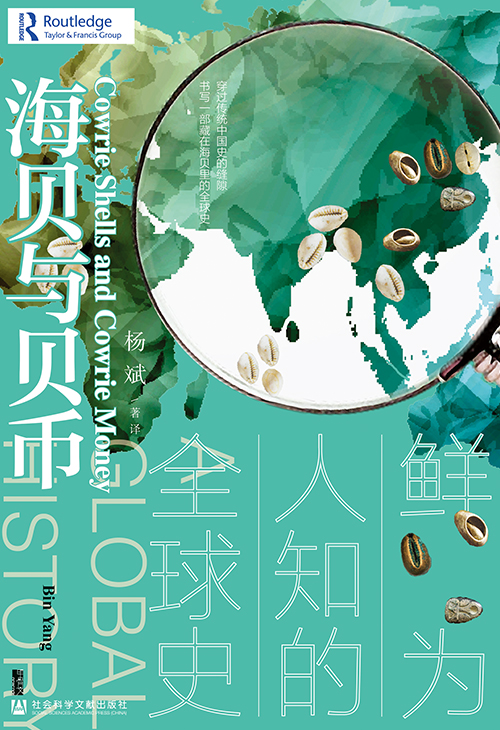Asia Book Awards
Best Asian Books of the Year

Cowrie Shells and Cowrie Money: A Global History (海贝与贝币:鲜为人知的全球史)
China, Jiaguwen(Social Sciences Academic Press), Bin Yang
Author
The author is a Ph.D. candidate at Northeastern University in the United States, a professor in the Department of Chinese Literature and History at the City University of Hong Kong, a member of the Xiling Seal Art Society (西泠印社), which studies gold stone seals, and a visiting scholar at Harvard’s Yanqing Institute (2011-2012). He has taught at Renmin University of China, the College of William and Mary, the National University of Singapore, and the Macau University. His research interests include maritime history, world history, history of science and medicine, and history of art. His doctoral dissertation, 《Between Winds and Clouds: The Making of Yunnan》 won the American Historical Association’s 2004 Gutenberg-E Prize(published by Columbia University Press in 2008), The Chinese version, 《季风之北,彩云之南:多民族融合的地方因素》, was published by Guangxi Normal University Press in 2023. His second full-length English-language book, 《Cowrie Shell and Cowrie Money: A Global History》was published by Routledge in 2018, and the first Chinese-language edition was published in 2021. Another Chinese-language book, 《人海之间:海洋亚洲中的中国与世界》, was published by Guangxi Normal University Press in 2023. His English-language articles in internationally recognized journals include 《Bulletin of the History of Medicine》、《Journal of Women’s History》、 《Journal of World History、 《The China Quarterly》、《American Historian Review》、 《Modern Asian Studies》. His third full-length book in English, currently in the process of completion, is titled 《Ambergris of the Maldives: A Study of Maritime China, c. 1100-1620》, will be published by Columbia University Press in the near future.
Publisher
Jiaguwen(甲骨文)
“Jiaguwen” is a book brand under Social Sciences Academic Press, which specializes in publishing excellent books in the humanities and social sciences. Since 2013, the publishing house has published more than 300 titles, including “Autumn in the Heavenly Kingdom(天国之秋)”, “Lawrence of Arabia(阿拉伯的劳伦斯)”, The publisher has translated and introduced excellent, entertaining and valuable bestsellers from Europe and the U.S., bringing awareness and understanding of previously unknown parts of the world and history to Chinese readers. At the same time, they strive to provide the best reading experience for their readers by designing the covers of all their books to meet the standard of “the most beautiful book”.
Social Sciences Academic Press(社会科学文献出版社, SSAP)
Founded in 1985, SSAP is an academic book publishing house specializing in the humanities and social sciences under the Chinese Academy of Social Sciences, with a publishing philosophy of “creating social science books and publishing literature for the world” and a positioning strategy of “authoritative, cutting-edge, and original”.
SSAP integrates academic resources from all over the world, focuses on academic research and development and dissemination of academic achievements, and has formed a catalog based on papyri, overseas journals, academic monographs and periodicals, and large-scale ancient texts, giving birth to popular academic brands such as 甲骨文, 索·恩, 启微, 九色鹿, 思想会, 方寸. SSAP has an important influence in China’s humanities and publishing fields.
This is a unique book of world history. Especially, this book describes the origins and spread of shell money and its relationship to Asia and the rest of the world.
1.
This book have rich and diverse texts. It draws on literature and research in several languages, including Chinese, English, Thai, and French. Synthesizing archaeological discoveries in China and abroad, this book is a comprehensive study of Cowrie shells and the phenomenon of ‘Cowrie money’ in human history. It analyzes the background, logic, patterns, and development of how Cowrie shells became (or did not become) currency in various parts of the world.
2.
This is a study of a long history. The book begins in the Neolithic era and ends in the mid-20th century, spanning four to five thousand years of history, and attempts to break the linear concept of “traditional-modern” time in historical narratives.
3.
This book has a narrative of a large geographical space. It takes a trans-regional approach, covering Asia, Africa, Europe, North America, the Indian, the Pacific and Atlantic oceans, bridging land and sea. It is extremely rare for a historical study book to cover such a large spatial scope as this book does.
4.
This study adopts an interdisciplinary research method. This book closely combines maritime history, trade history, numismatic history, and world history to present a new concept of “The World of Shell Money,” which provides a precedent for the study of world history.
5.
This book has received wide acclaim in Anglosphere.
Because Cowrie money originated in Asia, and its use and networks were formed in Asia, it symbolizes Asian traditions. It is also a metaphor for the tools and sacrifices by which Europe shaped its colonialist hegemony in Asia and around the world.
The book details the important role that Cowrie, a sea shell found in abundance in the Maldives archipelago. Cowrie was served as currency in many Asian societies(e.g., Bangladesh region, ancient China, continental Southeast Asia, Ryukyu Islands, and West Africa) and played in politics, economics, religion, and culture.
This book reconstructs and explains the complex process of European colonization of Asia. It points out that Europeans borrowed from Asia’s indigenous resources, relied on Asian trade networks, and adopted its traditions, but gradually penetrated, controlled, and discarded them. The disappearance of Cowrie money is thus an example, process, and symbol of the destruction of Asian traditions by European colonialism.
This work analyzes the role and process of globalization in the establishment of modern European hegemony. White silver from America, slaves from West Africa, opium from Asia, and sea shells from the Indian Ocean allowed Europe to take immeasurable wealth through plunder and unequal trade in Asia (also Africa and America). This led to the “Rise of the West,” the formation of global hegemony.
